By Eric Vandenbroeck
My 2015 travels to Myitkyina and Kachin State
Back in 2012 I reported about
the Burmese armed forces fight against the
Kachin and China’s collusion with the Myanmar Government.
Unfortunately in spite of the
recent election results not much change is noticeable in Kachin State. Attacks
by the Burmese armed forces are ongoing.
Only weeks ago when people of
a village that came under attack fled
for their lives in a panic, 22 sick,
elderly and disabled persons were
left in their homes without that any aid group was being allowed to move near
the village and help. And this has been going
on for years.
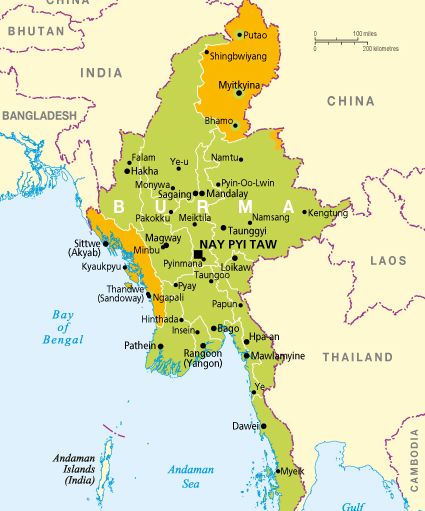
A lot of the current fighting is taking place in the area around
Hpakant, not surprising one of the leading jade-producing zones.
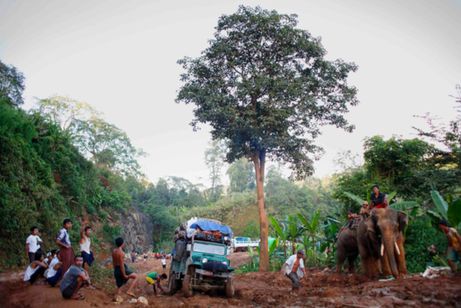
Above a truck stuck on the muddy road to Hpakant, waiting to be dragged
out by elephants. Huge amounts of precious jade have been mined in Hpakant over
decades and yet in Kachin State there are insufficient schools and supply of
electricity, and the roads are in very poor condition.
Discuss jade with a Kachin and they invariably hark back to the old
days, when families could draw on Hpakant’s natural riches to build homes and
make their livelihoods. However, since the military junta parcelled
the jade mines out in the early 1990s, the industry has gone from a small-scale
business in which many local miners could participate to one run by government
approved companies who are often backed up by military force (see below).
From my current position on the outskirts of Myitkyina, the results of
the fighting are noticeable as many
fled to safety here. Upon my arrival, I also found out that next to
Myitkyina airport there is a large military base, and overall, there are more
than 40,000 Burmese soldiers stationed throughout the state. Starting in
October the government has deployed 20 battalions, heavy artillery, and fighter
aircraft.
While my focus here is not tourism, neither is Myitkyina, a hot ticket
for foreigners in general. That probably could have changed if the government
had seen the potential for ecotourism and tiger spotting safaris. At the urging
of American biologist Alan Rabinowitz, known in conservation circles as “the
Indiana Jones of wildlife protection,” the Burmese government designated 13,600
square miles for the world’s largest tiger reserve in the Hukawng
Valley and then promptly set about logging the ancient teak forests and selling
the gold mining rights in much of it to the Yuzana Company, a Burmese business
conglomerate founded by a politically connected tycoon subject to American
investment sanctions who is now a member of Parliament. The Yuzana Company not
only started stripping the tiger habitat of its forests*, but it also seized
(with military backing) hundreds of thousands of acres of Kachin farmland
belonging to the residents of seven villages who had no other means of making a
living. It even tore up roads built by the farmers so they would be forced to
use company roads and pay their tolls.
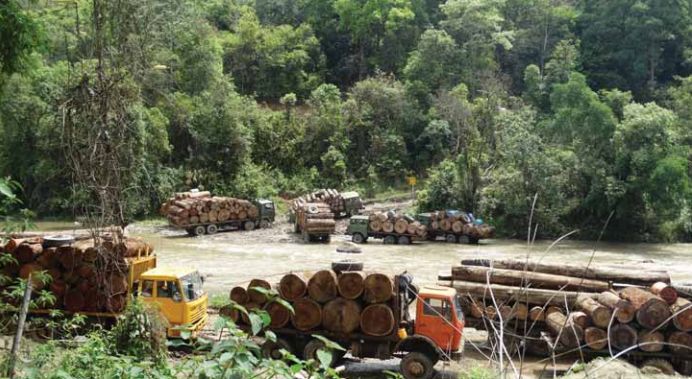
*In 2012, EIA research revealed that China
was the world’s biggest consumer of Burmese illegal timber, having imported
at least 18.5 million m3 of illegal logs and sawn timber in 2011, worth $3.7
billion, constituting 10 per cent of China’s total wood products imports.
The official Wildlife Conservation Society reports that still some
Tigers supposedly remain in the Hukawng, locals, in
contrast, are reporting that there are no more tigers. In any event, the
numbers are not likely to increase as the Yuzana Company’s gold mining strips
the land bare and releases cyanide contaminating the area soil as well as its
water sources. Leave it to the old school generals of Burma to create the
world’s largest tiger reserve with the fewest tigers. Just as Orwell’s
“Ministry of Plenty” from his novel Nineteen Eighty-Four rations and reduces
the supply of food and other goods while claiming to raise the standard of
living, Myanmar’s Ministry of Environmental Conservation and Forestry
(previously known as the Ministry of Agriculture and Forests) seems to be
hell-bent on selling rather conserving the country’s resources.
Unfortunately, this
kind of land grab is a common occurrence in Myanmar. Sometimes a few farmers
are displaced, and sometimes it’s whole villages. The new claimed democratic
reforms seemed to have little effect on this pursuit. The news website The
Irrawaddy reported in 2014 that a court near Mandalay had sentenced around 350
villagers to prison terms for essentially complaining about having their lands
stolen by the government and given to a private businessman.
Although the hills
around here at the moment seem peaceful to me, the people of Shan State are
well-accustomed to struggle. In the 1960s, Burma's dictator, General Ne Win,
launched a counter-insurgency strategy called the “Four
Cuts,” which were allegedly designed to cut the four main links that rebels
had to food, funds, intelligence, and recruits.
The “Four Cuts” is a
name that connotes precision and strategic thinking, but I guess that calling
it more accurately the “Village Burning Policy” lacks a certain pizazz. The
terrible thing about it is that it has never stopped. Over the years, many in Shan
State have been forcibly relocated, and it is still happening.
Even in 2015, the year of the big presidential election when things are
supposed to be different, villagers in southern Shan State are being forced off
of farmland to make way for a military golf course in the village of Kholam. In an interview with the Democratic Voice of Burma,
one
farmer stated, “I lost all my 10 acres… It includes my farm, garden and
paddy fields. I can’t go to my farm. Soldiers are guarding the area. I have
nowhere to work. Everybody is facing problems, all of us in the district.” that
these farmers initially came to the area when their previous villages were
burned in the “Four Cuts” strategy. First, they have their villages burned and
are forced to flee to another area. Then they are being forced to move again.
Generally speaking, Kachin society includes a variety of different
linguistic groups with overlapping territories and integrated social
structures. These are notably the Rawang, the Lisu, the Zaiwa,
the Lashi / Lachik
and the Lawngwaw and Jinghpaw.
Such definitions carefully distinguish Kachin and Shan (Tai) people though some
Kachin people have defied the Western expectation of lineage-based ethnicity by
culturally becoming Shans.
For the Kachin, the Burman failure to honour Panglong, or what they call the “spirit
of Panglong”, is the original sin of modern Burma.
Officially, the Kachin, should be equal citizens with the Burmans,
enjoying, all the same, rights and opportunities. But the real story has been
and continues to be, very different. Religion (many Kachin are Christian) has
come to be just one of many markers by which the Buddhist Burmans discriminate
against them. They are treated as second-class citizens, or worse, in their
country, and this has been both a cause and a consequence of the bloody civil
wars that most of these peoples have fought with the central Burman authorities
since independence. Thus, the division between the ethnic Burmans, who mainly
occupy the low-lying central plain of the country, and the ethnic groups along
the country’s extensive, winding borders, remains the most serious fault line
in the country. Geography counts for much here. The horseshoe-shaped ethnic
minority region surrounding the Burman core is the distinctive
politico-geographic feature of Burma.
Probably about one-third of the people in the country is non-Burmans. If
the conflicts that this horseshoe fault line has produced are not resolved,
then Burma will never have peace or prosperity, for the first is a prerequisite
for the second. And it is in Kachin State, in the far north of the country,
stretching from the central plains to the foothills of the Himalayas, that the
differences between the ethnic minority groups and the ruling Burmans are at
their most stark. Thus, the real test as to whether the Burmese government
wants to reform, and whether Burma can genuinely look forward to a peaceful,
democratic future will be here, in the lands of the Kachin.
A view repeated by leaders of the Kachin, Karen and Shan, points to the
ongoing rift between the ethnic minority groups, their political parties and
the NLD, is that Aung San Suu Kyi does
not care deeply enough about the ethnic issues, and does not refer to the
Panglong agreement enough. Ultimately, they do not see their interests as being
naturally aligned with the Burman-dominated NLD, and Aung San Suu Kyi had not
done enough to make up for that in her hopes to form a broad, nationwide
coalition to replace the military-dominated governments. It is clear to all
that her immediate concern is with the handover of power to her by the present
government. She wants nothing to be in the way of a smooth transfer.
About 40
miles away from Myitkyina, in the town of Laiza, the Kachin Independence
Organization (henceforth KIO) maintains a stronghold where Kachin
refugees have flocked after surviving encounters with the Government Burmese
Tatmadaw army. I question how long they can defend themselves against
bigger numbers and more advanced weapons.
Asking about the general situation today, a resident of Myitkyina said:
“The generals are thinking they are Burmese kings like in the old days of
history. They think everything belongs to them – the jade, the trees,
everything. Now they look for oil to sell to the Chinese.”
This was confirmed by a recent report that came to the conclusion that
the value of official jade production in 2014 alone was well over the US$12
billion indicated by Chinese import data, and appears likely to have been as
much as US$31 billion. To put it in perspective, this figure equates to 48% of
Myanmar’s official GDP and 46 times government expenditure on health. Clearly,
if openly, fairly and sustainably managed, this industry could transform the
fortunes of the Kachin population and help drive development across Myanmar.
Instead, the people of Kachin State see their livelihoods disappear and their
landscape shattered by the intensifying scramble for their most prized asset.
As seen from an incident a few weeks ago conditions in jade mines are often
fatally dangerous while those who stand in the way of the guns and machines
face land grabs, intimidation, and violence.
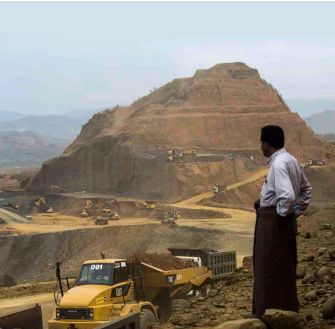
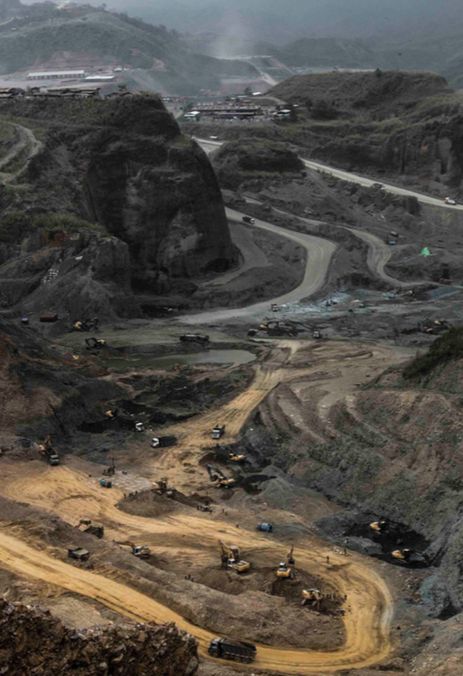
The Kachin know all too much about foreign investment, and particularly
the rapacious and destructive side of it. For the Kachin, more than any other
of the ethnic groups in Myanmar can see perfectly well that if they were
allowed a fair share of the fabulous mineral riches that have been extracted by
outsiders from beneath their feet they would now be relatively wealthy, rather
than crushingly poor. This compounds their sense of grievance. For Kachin State
contains many of the country’s biggest and most valuable mines, mostly of jade
and amber, but also of gold. Many of the largest mines are clustered around
Hpakant, said to be home to the highest concentration of bulldozers in the
world – 12,000 or so of them. Here, entire hills and mountains regularly disappear
in the mechanised quest for jade. Such is the demand
for the famously dark-green stone from the Kachin hills that a jade bracelet
sold just over the border in China can fetch up to several thousand dollars.
The Kachin see almost none of this money, which ends up mostly in the pockets
of the Burman generals.
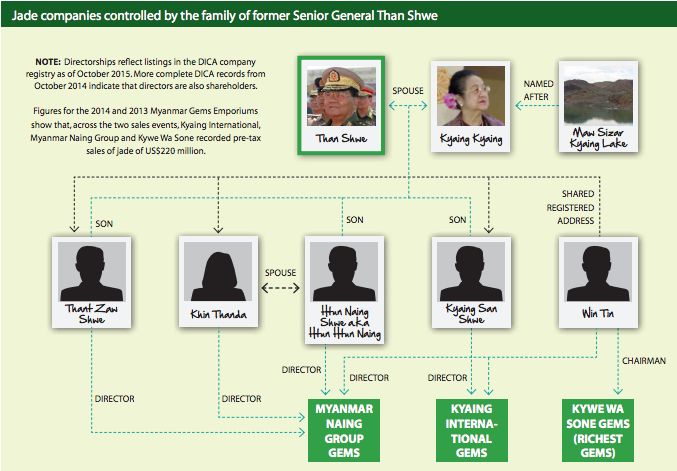
Myanmar’s jade industry may well be the biggest natural resource heist
in modern history. The sums of money involved are almost incomprehensibly high,
and the level of accountability is at rock bottom. As long as the ghosts of the
military junta are allowed to dominate a business worth equivalent to almost
half the country’s GDP, it is difficult to envisage an end to the conflict in
Kachin State. Lessons from other nations afflicted by the resource curse, as
well as Myanmar’s history, suggest that the threats to the country’s wider
political and economic stability are also very real.
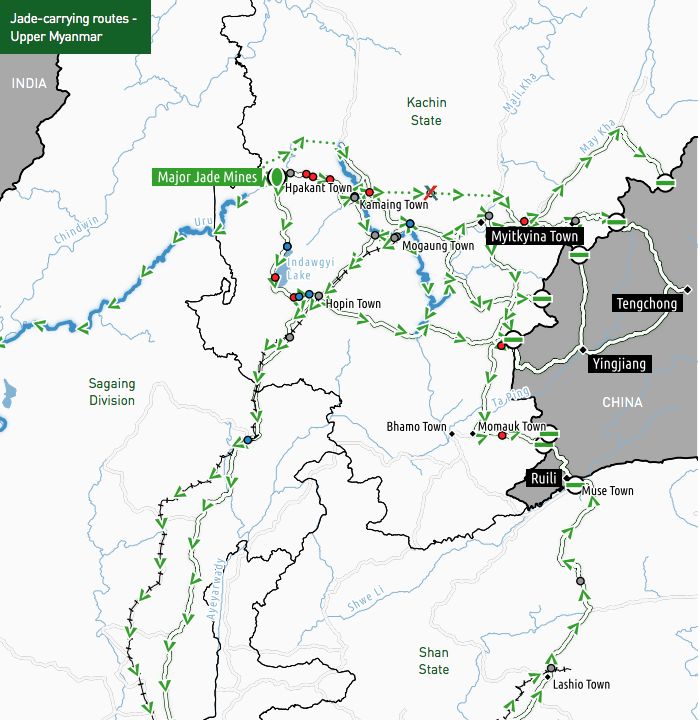
Unfortunately so far there is no sign of this after the elections. Or as
one of the leading mine companies commented yesterday: "Until
now, Aung San Suu Kyi hasn't been able to influence the military, so I don't
think an NLD government can either.”
Because of the stepped-up extractions, thousands of ethnic villagers are
being forced off their land. Scavengers, or "handpicked" who in their
thousands scour mountains of loose earth and rubble for nuggets of jade, are
sometimes buried alive, including 114 killed in a
landslide last month.
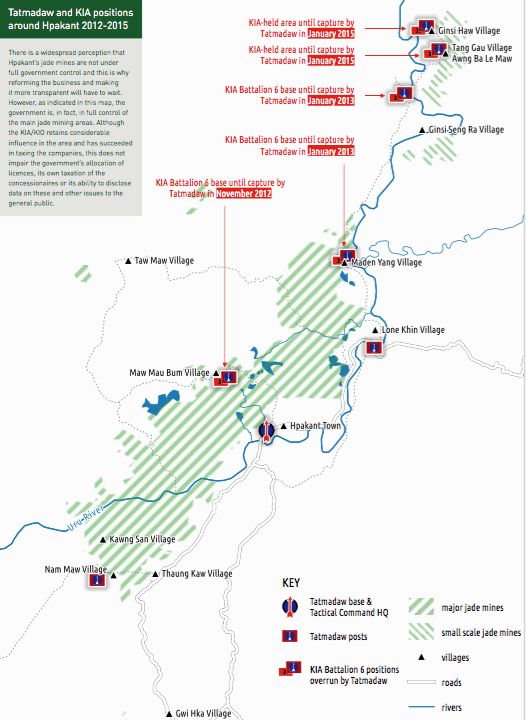
The above map is based on a study done in January 2015. Whereby the
major Burmese armed forces attacks that started early October were intending
completely eradicate all remaining influence of the KIA/KIO in the area for the
generals to take control of the resources.
Below a Burmese Tatmadaw soldier walks through a jade mining site as the
police and military forces come to arrest illegal jade miners and the miners’
families stand and shout in the background. The Tatmadaw systematically extorts
from illegal miners and demands a payment of 20% of the value of each stone
that they find; generating a substantial off-budget revenue stream.
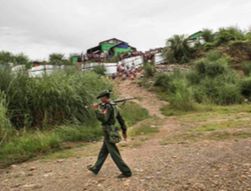
Through its administrative structure, the military government today has
complete control, including of all the schools in the state, tax revenues,
hospitals, the judiciary and, of course, the police.
The Kachin were hoping that the ceasefire
in October would have lead to political talks to
address their numerous grievances. In Laiza, the Kachin established a lively
and authentic Kachin cultural identity, producing school textbooks in Jinghpaw, for instance, and teaching people their history.
But in Kachin State itself, it was more of the same, merely a further
deterioration in the rights, status and culture of the Kachin. But the war only
exacerbated the differences between the Kachin and the Burmans, and this
continued.
Kachin Independence Organization estimates that 15,000 people were displaced because of the project.
Shan State’s 10,000-plus are internally displaced
people (IDPs) are now dispersed between more than ten locations in six
townships.
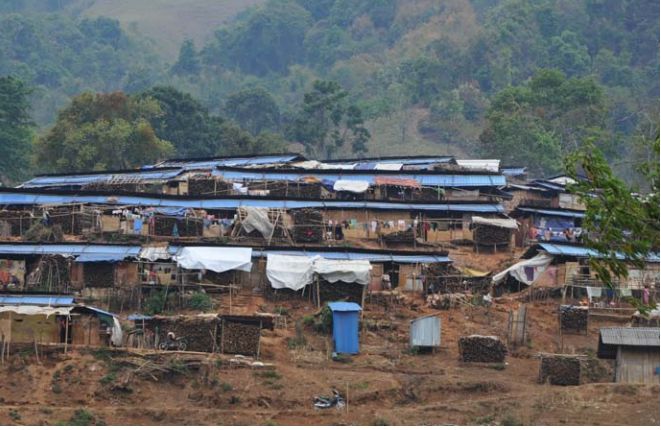
Below and above two camps of
displaced people in Shan State.
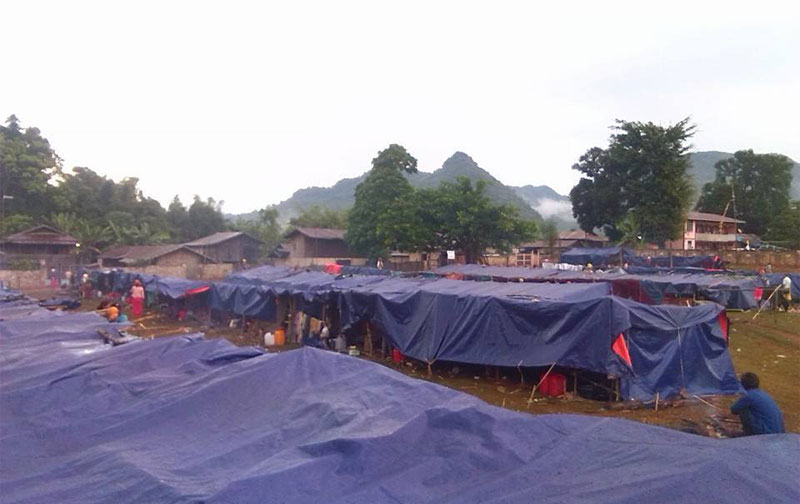
Unfortunately, while the election was a step in the right direction,
Myanmar will not be able to enjoy democracy simply because the NLD won the
election. One of the reasons for this is because the election was held under
2008 Constitution, which was adopted from the military’s seven-point roadmap
that enshrines power to the institution.
A major problem for Kachin, as was also the case in many other ethnic
areas of the country, was that of voting
cancellations. The Kachin Democratic Party candidate told one of my
contacts today that ethnic parties in Kachin state the incoming government to
hold by-election soon. “Even if the
by-elections are held, we still won’t be able to form a government, but I want
to know how much understanding and priority the new government will have with
regards to ethnic parties,” he said. In other
areas of the country there are similar situations.
But while the United States and Canada might send election observers to parliamentary
by-elections someone of the diplomatic mission in Yangon told me over the phone
today that the perception is that the Myanmar governement
had not met international standards in this regard.
Sharing similar views as many of the Kachin I spoke to, David Tharckabaw recently mentioned in an interview:
“It would be hard for Ms Suu Kyi and the NLD to
wrest total control away from the military...The military holds three important
ministries – defense, interior and border security. Whatever government is in
power, to be effective in governing the country it needs to amend the
Constitution. That will be difficult. To change the Constitution, the parties
have to get 70% plus one; one from the military. That means the military have
something like veto power again. In reality, they are controlling the power
with the three ministries I mentioned...The national ceasefire will have to be
renegotiated. The Nationwide Ceasefire Agreement was initially demanded by the
ethnic resistant organizations. Of course, the government delayed because they
still want to carry out their strategy of attacking some, making ‘peace’ with
others. The talks have been going on for nearly five years, but with no real
nationwide ceasefire achieve. If the NLD become the government, they have to
lead the peace process. They have to lead the negotiations...Unless we have
real peace, there will be no change. The military and their cronies will
dominate the economy.”
While in reference to Suu Kyi a neutrally worded policy
briefing about the November election today stated: “Unless, however, the
NLD can really reform the structures of national politics, there are already
concerns that the party could go the way of AFPFL governments in the
parliamentary era of the 1950s, concentrating on party politics in the national
capital, failing to end conflict, and continuing the marginalization of
minority peoples.”
Shan Nationalities League for Democracy Chairperson Khun Htun Oo
yesterday criticized Burma’s draft Framework for Political Dialogue (FPD) for a
lack of inclusiveness:
“This
way, it will be like the Two Trees Convention that was held by the military in
the past,” the 72-year-old former political prisoner said, referring to
Burma’s National Convention, a process initiated in 1993 to write a new
national constitution and which ended with the much-criticized 2008
Constitution.
For updates click homepage
here